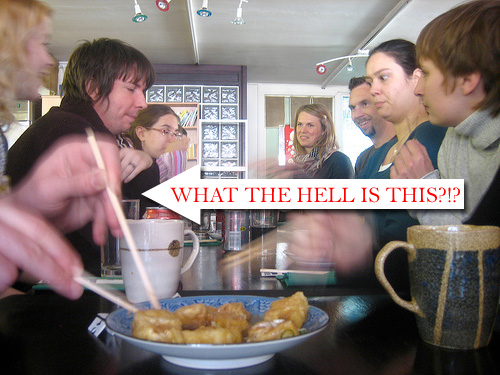
I’ve been in Hawaii the past week or so, a few days of which was spent with my host family from when I home-stayed in Japan in high school. Having them over here in America (though, Hawaii is about as Japanese as America gets) really brings out some of the subtle cultural differences between Japanese people and Americans. Particularly, though, we spent a lot of time at restaurants, so I thought I’d talk a bit today about Japanese restaurant culture. When at various eating places, it made me realize how things in Japanese restaurants are done a little bit differently. Nothing drastic or too strange, but things that are good to know when you’re over in Japan.
Calling Out For Service
This was something that surprised me a little when living in Japan. People call out to the waiters/waitresses for service. You don’t wait for someone to come to you, you tell them when and why you want them over at your table. When we went out to restaurants here in Hawaii, I had to tell them not to yell at the waiter to come over every couple of minutes, despite their irritation that nobody was coming to take their orders when they wanted.
I could be wrong about this, but I consider it rude to call out to waiters / waitresses when you want something. I’m not talking about a soft “excuse me” or a wave to get their attention, I’m talking a fairly loud shout across the room when you want something. In Japan, however, it’s okay to do this. Feel free to shout out a moderately loud “sumimasen!” or even a “suman!” if you’re a little drunk and rude. This is a good way to get someone’s attention, as some places might be waiting for this call before they come by.
Tiny Glasses of Water
I’m someone who needs to drink a lot of liquids at a meal. I like the big glass of water, and I drink it down fast. In fact, the percentage of my tip is completely dependent on how good a place is at refilling my water. A really good water filler will get 20% from me, whereas someone who does a poor job will get 10% or lower, depending on how everything else is.
In Japan, however, they like things small. Most places only give tiny glasses of water, and do a fairly poor job refilling. My host family always commented on the large glasses of water when they were here in Hawaii, while when I was over there I’d comment about how small they were. It’s just how it is. One good way to get around this is to ask them to put your water in a beer glass / beer mug. Those tend to be much larger, and will help you survive more of the meal if you’re big on liquids, like me.
Oh, I suppose you can call out to your waitress / waiter as well, and they’ll refill your water for you. For me, though, that would be like every minute, and got embarrassing after a while.
Getting Food Even When You Can’t Read the Menu
I know a lot of people make their way to Japan without being able to read Japanese well. If you can’t read at least hiragana/katakana, I can’t help you. A lot of places will have pictures, or even plastic models of their main courses, so if this is the case you can point and say “kore, 1, kore, 1.” But what about when you go to a mom ’n’ pop shop type food place? Their menus are written or typed out, bare, simple, and lack pictures.
Luckily, you’ll find a lot of places using katakana within their menu items. This is a good secret to know. If you are at least familiar with different types of foods, and you can read katakana, you can at least find a few things on the menu you might be interested in. For example, things like “katsu” and “ramen” tend to be written in katakana. That will get you a little closers to finding what you want, anyways. At that point, you can point and say “kore, 1” without completely guessing.
Then again, if you’re adventurous, go for it. Japanese food is usually pretty awesome, no matter what you get.
Grabbing Food From the Communal Platter
When doing a “family style” meal, where there’s food in the middle and everyone takes from it, there are often times where you will use your chopsticks to get at this food. I’ve heard a couple of takes on this. Some people say close friends and family shouldn’t use the back (or fat) ends of their chopsticks to take food, since using the eating sides of your chopsticks shows how close you are. With family, yes, I think this is very common. With close friends, I’m not sure. I would just see what other people are doing, and follow along.
If you are eating with people that aren’t really close friends or family, then yes, it’s important you turn your chopsticks around to grab the food. If you don’t know how to use chopsticks, then you should probably turn your fork around and look like the idiot you are for going to Japan without learning how to use chopsticks beforehand.
Fighting for the Bill
I thought fighting for the bill here in America was hard enough. In Japan, it’s like a no-holds-barred fight-to-the-death cage match. It’s important to fight hard to pay for the bill, especially if you’re older. Usually, the person who is higher up on the hierarchy ladder tends to pay, but that doesn’t mean you shouldn’t try to pay too. It really depends on the relationship with the people you are eating with, though. From my experience, a senpai 1 will try to pay for a kohai 2, though splitting the bill seems to be more common than before. Still, though, make sure you insist on paying for something, even if you plan on losing the bill paying battle. If you lose, insist you will pay next time, and try to do it. Japanese people tend to keep track of gifts and who owes who what, so it’s a good idea to try and repay someone for their kindness if you can with something of a similar value. This goes for all presents and gifts, not just food. Luckily, though, younger folks are exempt, just like in America.
No Tipping
It’s lucky that you don’t tip in Japan (at all), because otherwise restaurants wouldn’t get anything from me due to their weak water refilling skillz. No matter how great the service, you don’t have to tip, saving you around 15% at each meal. Even if you think Japanese food is expensive (and it isn’t, really, if you go to the right places), you are saving money not having to tip, which I think is pretty sweet. I also haven’t seen a lack of service due to the lack of tipping, which is also nice. It’s just not part of the culture.
My host family always complained about having to tip everywhere here in Hawaii – they just don’t know how easy they have it!
Time to Go Eat!
I hope this helps you a little bit with going to a Japanese restaurant. It’s probably best to avoid places that have “No Gaijin” printed on the front of their stores, which sadly still exist, though are fairly rare. Don’t let a lack of pictures / plastic models of food stop you from going somewhere. I’d say the best places are the mom ’n’ pop shops. Real down to earth cooking, right there, and the prices tend to be more reasonable while the portions are bigger.
